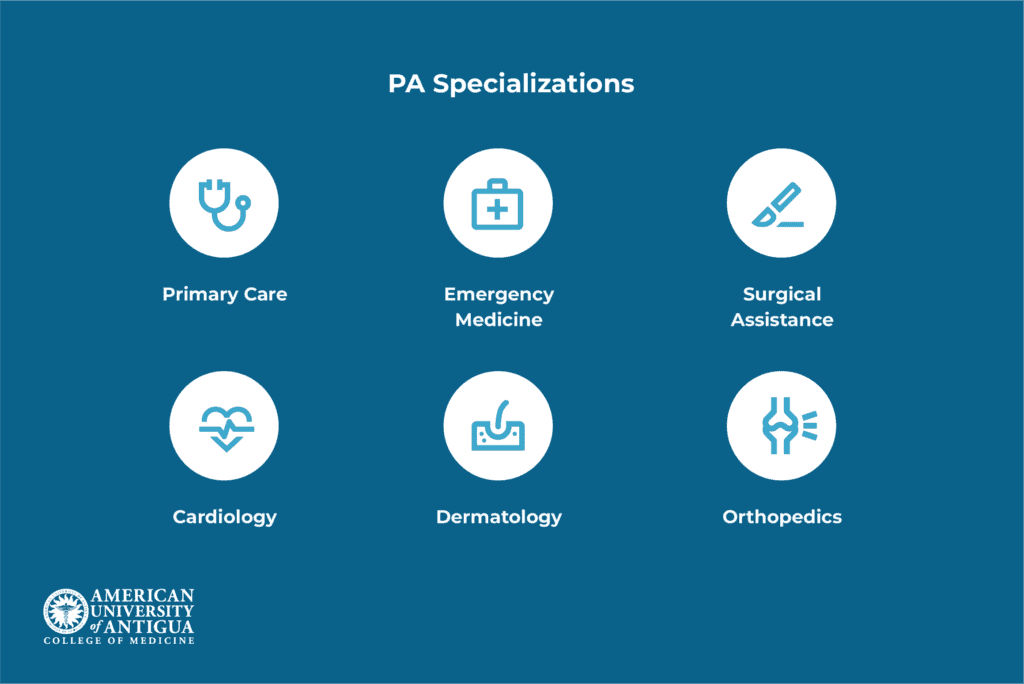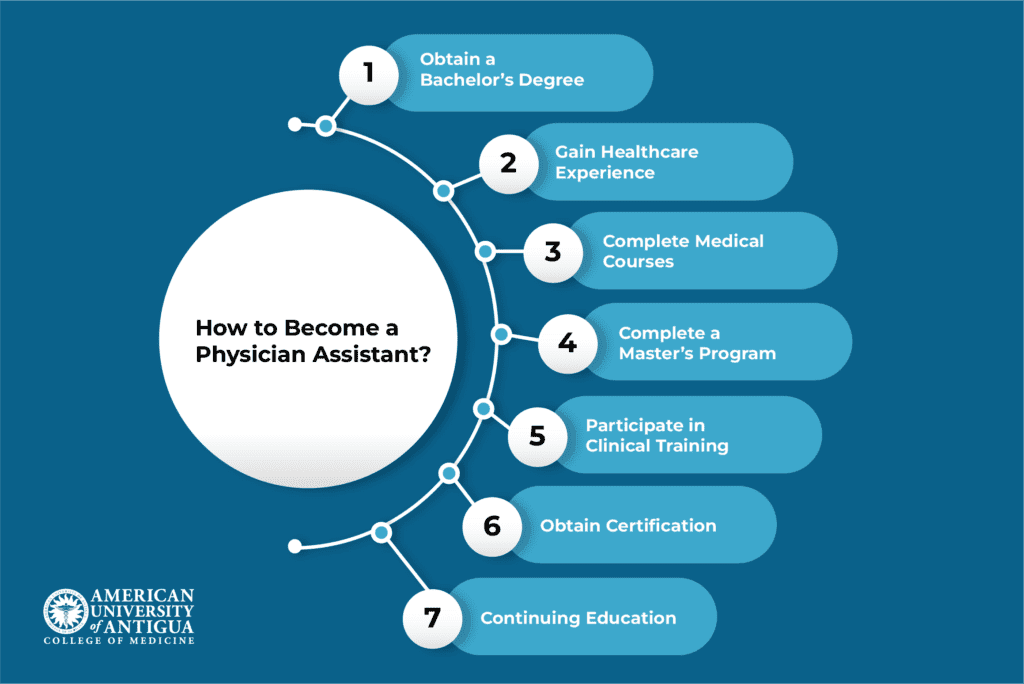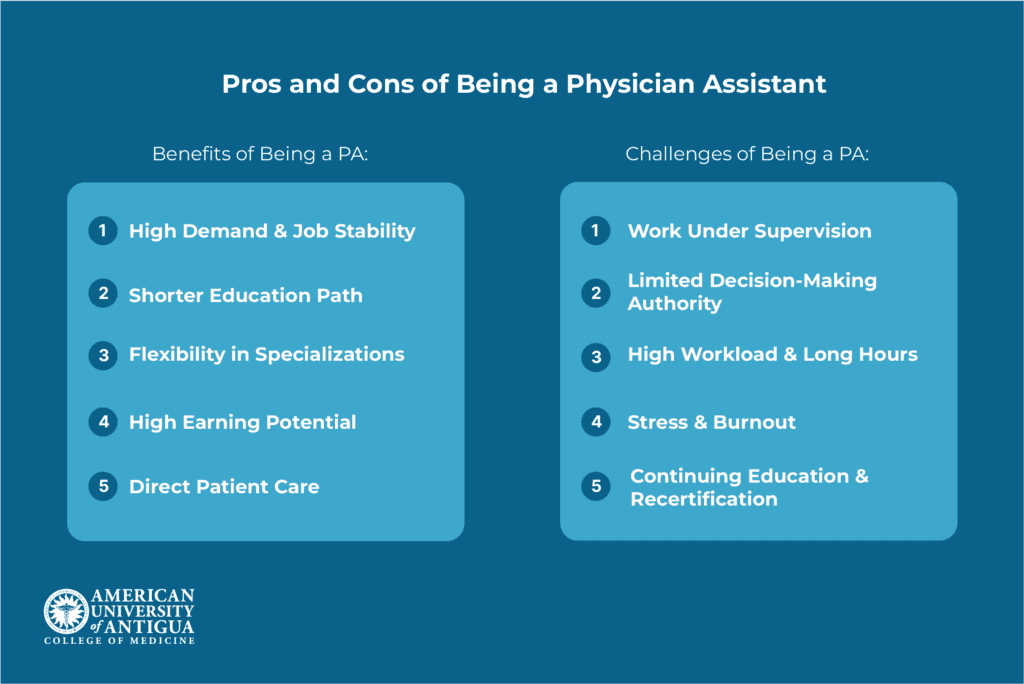What Is a PA? Responsibilities, Salary, and Career Path
Key Takeaways
- Growing Demand: PAs make up 8.2% of primary care workers in the U.S., with demand projected to rise by 28% from 2023 to 2033.
- Career Flexibility: PAs can transition between specialties without extensive retraining, offering diverse career opportunities.
- Competitive Salary: The median salary for PAs was $130,020 in 2023, with higher pay in specialties like surgery.
- Shorter Training: Becoming a PA takes 2-3 years of training after a bachelor’s degree, much faster than becoming a doctor.
Did you know that physician assistants (PAs) make up over 8% of primary care providers in the U.S., contributing significantly to expanding access to healthcare? As the demand for medical services grows, PAs are taking on increasingly important responsibilities in patient care. These medical specialists diagnose illnesses, perform a range of procedures, and collaborate with doctors to develop treatment plans.
This article explores the role of PAs, their career path, salary expectations, and how their function in the healthcare industry compares to that of doctors.
✅ Request information on AUA's MD program TODAY!
YOUR PATH TO SUCCESS BEGINS HERE
What Is a PA?
Physician assistants, or PAs, are medical professionals who team up with doctors, nurses, and other care providers to assess, diagnose, and treat patients. They play a vital role in diverse healthcare settings, including clinics, hospitals, and private practices.
Although both PAs and doctors diagnose illnesses and prescribe treatments, their educational paths and scopes of practice differ. PAs complete a master’s degree in physician assistant studies and get hands-on experience instead of attending medical school and completing a lengthy residency. This streamlined training allows them to enter the workforce more quickly, but they have to work under a doctor’s supervision.
What Does a PA Do?
PAs are essential medical professionals who play a key role in patient diagnosis and care. They perform patient examinations, order tests, develop treatment plans, prescribe medications, and assist in medical procedures. PAs work across various specialties, including pediatrics, emergency care, surgery, and family medicine.
Their responsibilities can vary depending on where they work. While many of their responsibilities are similar to those of doctors, there are notable differences. Unlike doctors, who often work independently, PAs are integral members of a healthcare team, providing patients with more access to medical care. For more complex cases, PAs consult with doctors because they’re working under their supervision.
Responsibilities
PAs have many important duties that help patients get the care they need. They perform physical exams to assess a patient’s overall health and recognize any potential signs of illness or medical issues. PAs are qualified to diagnose diseases, recommend treatments, and, in many states, prescribe medications.
They regularly order tests, such as X-rays and blood work, and use the results to develop tailored treatment plans. PAs help doctors by managing equipment, providing post-surgical care, and preparing patients for procedures. Additionally, they’re crucial in educating patients on managing their health, following treatment regimens, and making positive lifestyle choices.
Specializations

PAs can specialize in various medical fields, giving them the flexibility to pursue areas that align with their personal interests. In primary care, they help patients with routine checkups, treatment of common illnesses, and management of chronic conditions.
In emergency medicine, PAs are critical in handling severe injuries, infections, and life-threatening situations. In surgical settings, they assist surgeons by preparing patients, managing surgical instruments, and providing post-surgical care.
In cardiology, PAs focus on diagnosing and treating heart-related conditions. In dermatology, they address skin conditions such as acne, rashes, and skin cancer. In orthopedics, they manage musculoskeletal concerns, including fractures and arthritis.
Work environment
PAs practice in a variety of healthcare settings, including hospitals, clinics, private practices, and urgent care centers. In hospitals, they assist with patient admissions, surgical procedures, and emergency room care. In private practices and clinics, PAs perform examinations, diagnose conditions, and manage long-term health issues. Urgent care centers rely on PAs to treat sudden illnesses, infections, and minor injuries.
A PA’s work environment also influences their schedule. Those working in clinics usually have regular, daytime hours, while PAs in hospitals or emergency rooms often work longer shifts, including weekends and overtime. The fast-paced, high-pressure environments in hospitals and urgent care centers may offer rewarding experiences for those who thrive in such settings, but they can also be more demanding.
How to Become a PA?
Becoming a PA requires dedication, hard work, and a strong desire to help others. They play a critical role in healthcare, collaborating with doctors to deliver optimal patient care.
This profession requires the ability to make quick, well-informed decisions, a solid understanding of medical science, and excellent communication skills. To excel in this field, PAs must also demonstrate strong teamwork and problem-solving skills, empathy, and attention to detail.
Becoming a PA involves completing several important educational and training requirements, which we’ll discuss in more detail in the paragraphs that follow.

Educational requirements
The path to becoming a PA begins with earning a bachelor’s degree, typically in health sciences, chemistry, or biology. As part of this degree, students complete coursework in foundational subjects such as anatomy, physiology, microbiology, and chemistry. Many PA programs also require applicants to have prior experience in healthcare roles, such as medical assistants, EMTs, or nurses. This experience is vital for gaining practical knowledge in patient care.
Following this, PAs must complete a two- to three-year master’s program in physician assistant studies. These programs combine classroom learning with clinical practice, equipping students with the essential expertise needed to deliver high-quality patient care.
Clinical training & certification
After completing their academic studies, PA students participate in clinical training to acquire hands-on experience in a range of medical specialties. This training typically includes specialties such as family medicine, surgery, pediatrics, cardiology, and emergency medicine, providing students with the opportunity to put their knowledge into practice in real-world settings like hospitals and clinics.
After completing clinical training, graduates must pass the Physician Assistant National Certifying Exam (PANCE) to demonstrate their medical skills. Successful completion of the exam grants the PA-C (Physician Assistant-Certified) credential. To maintain their certification, PAs must engage in ongoing education and pass a recertification exam every ten years.
Lastly, to practice as a PA, individuals must obtain state-specific licensure, which often includes background checks and other documentation.
Pros and Cons of Being a PA
Being a PA is both a rewarding and demanding career. The positive impact PAs have on their patients’ lives makes the work incredibly fulfilling, even though it requires long hours, dedication, and stress-management skills. PAs enjoy excellent compensation, job stability, and the opportunity to work in a range of medical specialties.
The following sections explore the advantages and difficulties of pursuing a career as a PA in more detail.

Benefits of a PA career
A career as a PA offers a number of advantages, making it an excellent career choice for those interested in healthcare. One of the key benefits is the high demand and job stability — PAs are needed across many medical fields, and the demand for them continues to grow.
Compared to doctors, PAs follow a shorter educational path, allowing them to enter the workforce sooner and with less student debt. Another major advantage is the ability to switch specializations without needing extensive training, giving PAs the flexibility to explore different areas of medicine.
PAs also enjoy competitive salaries and strong potential for career growth. Most importantly, they have the opportunity to provide direct patient care, helping people improve their health and making a meaningful difference in their lives.
Challenges of being a PA
While a career as a PA is rewarding, it does come with its challenges. One of the biggest hurdles is that PAs must work under a doctor’s supervision, although the level of independence varies by state. This means they may have less decision-making authority than doctors, which can sometimes limit their flexibility.
PAs often have high workloads and long hours, especially in hospitals and emergency care settings, which can lead to stress and burnout. However, effective time management and a healthy work-life balance can mitigate these issues.
Another challenge is the need for ongoing education and recertification. PAs must stay updated on medical advancements and periodically pass exams to maintain their certification. While this requires ongoing effort, it ensures that PAs continue to provide the highest standard of care.
PA Salary and Job Outlook
PAs earn competitive salaries, with exact figures varying based on factors like location, specialty, and experience. According to the Bureau of Labor Statistics (BLS), the median annual salary for PAs was $130,020 in May 2023. Those working in specialized fields, like surgery or emergency medicine, typically earn even higher salaries.
The job outlook for PAs is also exceptionally strong. Employment for PAs is expected to grow by 28% from 2023 to 2033, significantly outpacing the average growth rate for most occupations. This growth is happening because more people need medical care, the population is getting older, and healthcare providers are looking for cost-effective ways to treat patients.
PA vs. Doctor: What’s the Difference?
The primary difference between a PA and a doctor lies in their education and training timelines. To become a doctor, you must complete 4 years of undergraduate education, followed by 4 years of medical school, and an additional 3 to 7 years of residency in your chosen specialty. On the other hand, to become a PA, you only need 2 to 3 years of graduate-level education after earning a bachelor’s degree, making the process much shorter.
In terms of scope of practice, doctors have greater autonomy and can make independent decisions, while PAs work under the supervision of a doctor, although the degree of supervision can vary by state.
Career flexibility is another key difference. PAs can easily switch between specialties without the need for years of additional training, while doctors must undergo extensive training to change fields.
Regarding salary, doctors generally earn more because of their longer education and specialized training. However, PAs still enjoy a good salary and often benefit from a better work-life balance due to shorter working hours and fewer responsibilities.
Conclusion
Becoming a PA is a rewarding career choice that offers high demand, job stability, and the opportunity to make a meaningful impact on patient care. With a shorter education path compared to doctors, PAs can start their careers sooner and enjoy the flexibility to switch specializations without undergoing years of extra training. Additionally, PAs enjoy competitive salaries and a healthy work-life balance.
If you’re passionate about medicine and helping others, pursuing a career as a PA might be a great fit for you. Explore AUAMED’s MD program and discover how it can help shape your medical career.
Frequently Asked Questions
How long does PA school take?
PA school typically takes 2 to 3 years to complete after earning a bachelor’s degree.
Who is the highest-paid PA?
PAs working in surgical specialties, particularly orthopedic surgery or cardiology, tend to earn the highest salaries.
Can a PA become a doctor?
Yes, a PA can become a doctor by completing medical school and residency, though it requires additional years of education and training.
✅ Request information on AUA's MD program TODAY!